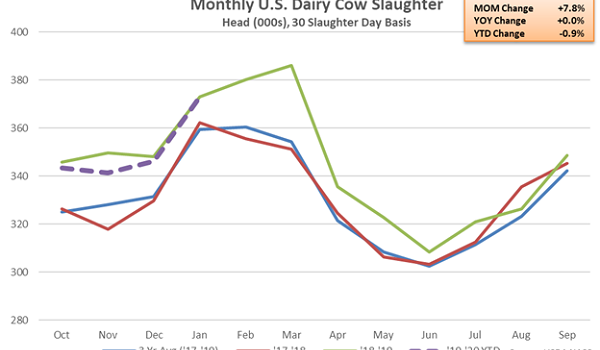
U.S. Dairy Cow Slaughter Update – Feb ’20
Executive Summary
U.S. dairy cow slaughter figures provided by USDA were recently updated with values spanning through Jan ’20. Highlights from the updated report include:
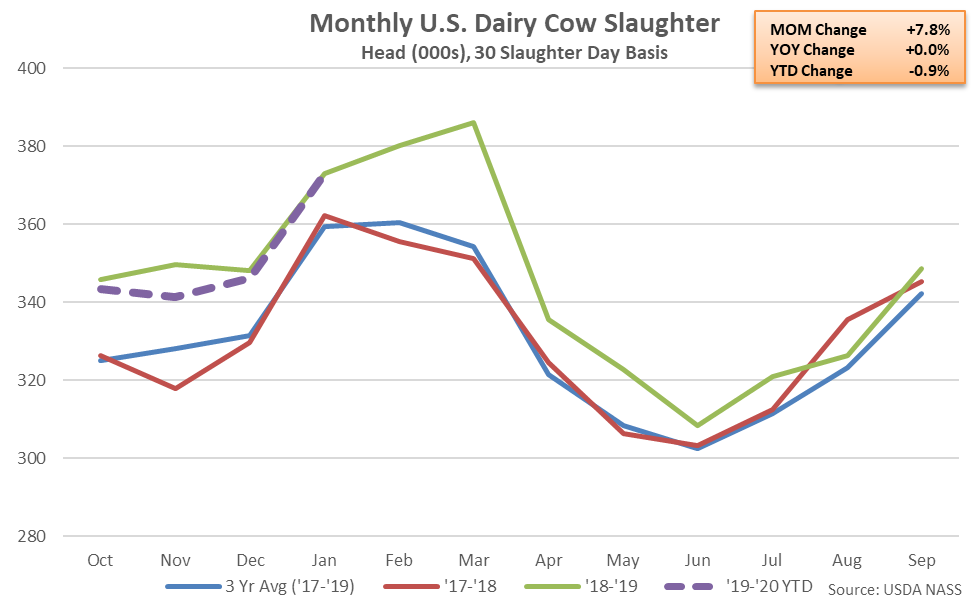 U.S. dairy cow slaughter rates had finished lower on a YOY basis over three consecutive months prior to finishing flat YOY during Jan ’20. Dairy cow slaughter rates had finished higher on a YOY basis over 30 consecutive months prior to the recently experienced declines. U.S. dairy cow slaughter rates have declined by a total of 0.9% on a YOY basis over the past six months.
U.S. dairy cow slaughter rates had finished lower on a YOY basis over three consecutive months prior to finishing flat YOY during Jan ’20. Dairy cow slaughter rates had finished higher on a YOY basis over 30 consecutive months prior to the recently experienced declines. U.S. dairy cow slaughter rates have declined by a total of 0.9% on a YOY basis over the past six months.
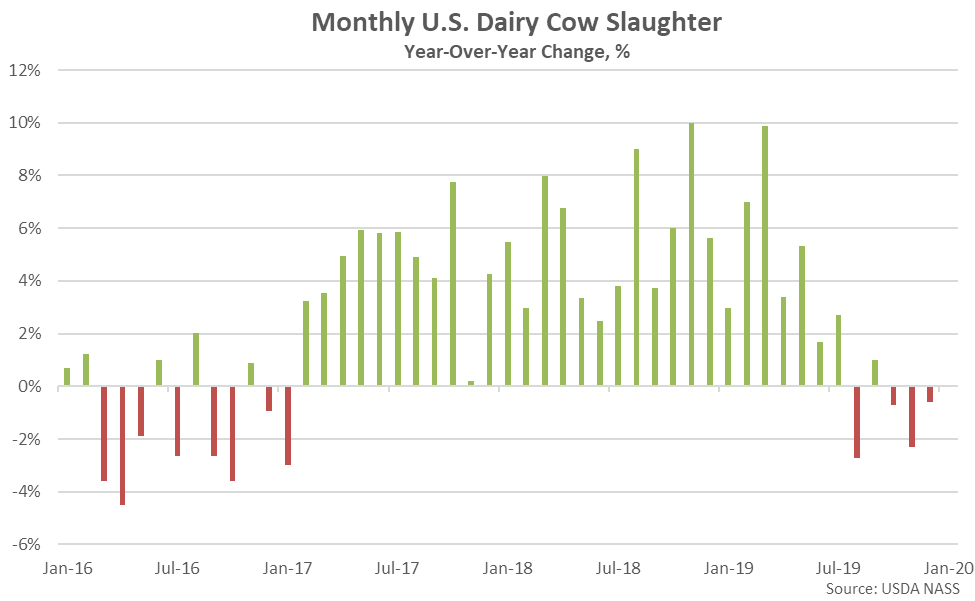 Recent declines in slaughter rates have contributed to the U.S. milk cow herd rebounding from the three year low level experienced during Jul ’19. The U.S. milk cow herd has increased by a total of 33,000 head throughout the past six months, rebounding to an 11 month high level, overall. The U.S. milk cow herd currently stands at 9.348 million head, which remains 6,000 head below the previous year and 90,000 head below the 23 year high level experienced during Jan ’18, however.
Recent declines in slaughter rates have contributed to the U.S. milk cow herd rebounding from the three year low level experienced during Jul ’19. The U.S. milk cow herd has increased by a total of 33,000 head throughout the past six months, rebounding to an 11 month high level, overall. The U.S. milk cow herd currently stands at 9.348 million head, which remains 6,000 head below the previous year and 90,000 head below the 23 year high level experienced during Jan ’18, however.
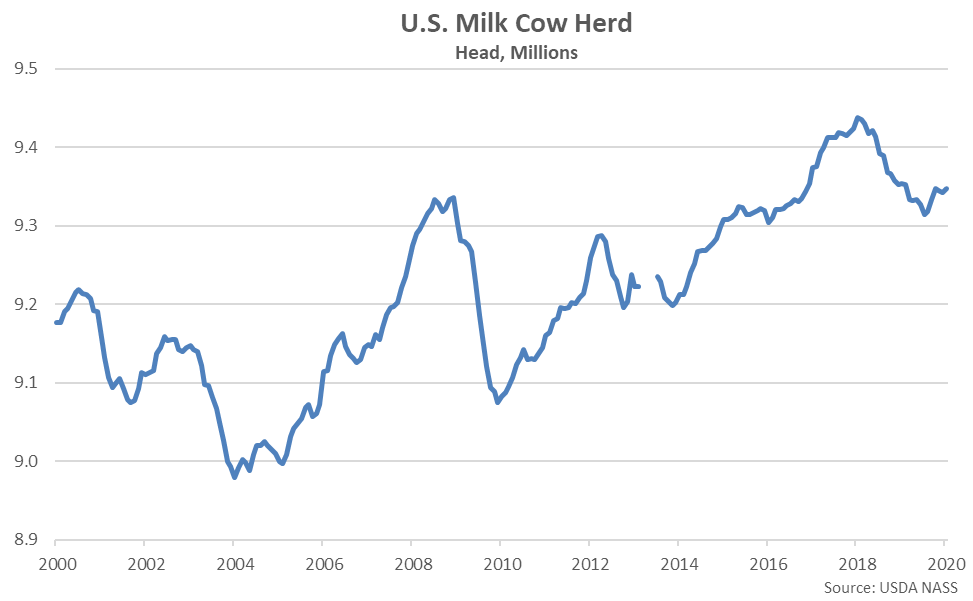 The most significant MOM increase in dairy cow slaughter was experienced within Standard Federal Region 9 (Arizona, California, Hawaii and Nevada), followed by Standard Federal Region 10 (Alaska, Idaho, Oregon and Washington).
The most significant MOM increase in dairy cow slaughter was experienced within Standard Federal Region 9 (Arizona, California, Hawaii and Nevada), followed by Standard Federal Region 10 (Alaska, Idaho, Oregon and Washington).
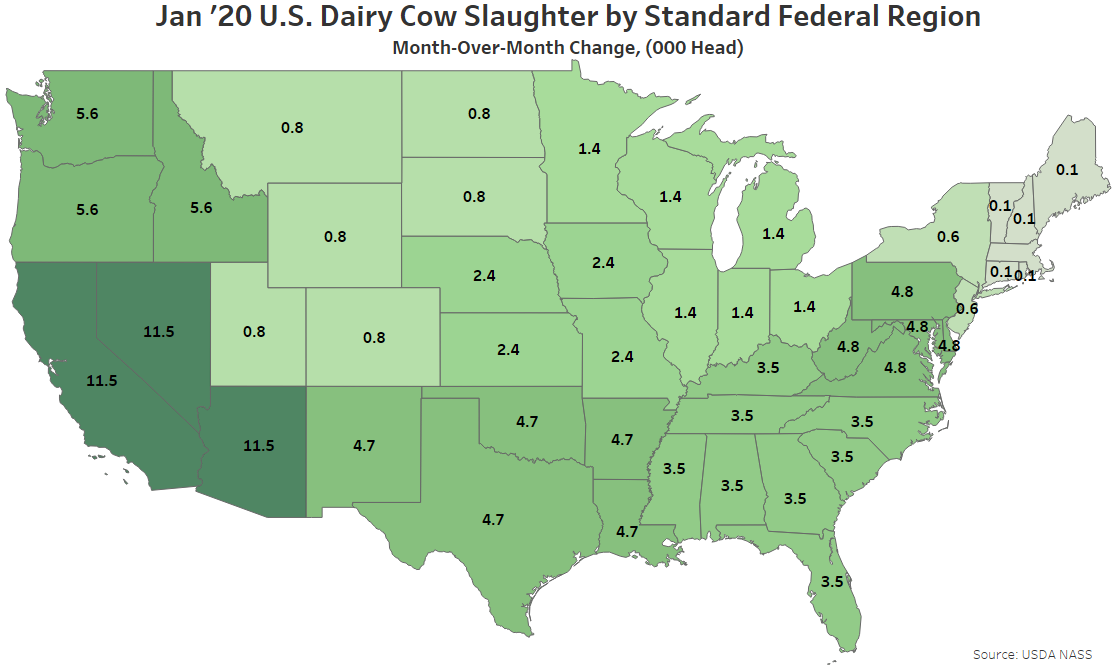 YOY increases in dairy cow slaughter were led by Standard Federal Region 9 (Arizona, California, Hawaii and Nevada), while dairy cow slaughter rates declined most significantly on a YOY basis throughout Standard Federal Region 6 (Arkansas, Louisiana, New Mexico, Oklahoma and Texas).
YOY increases in dairy cow slaughter were led by Standard Federal Region 9 (Arizona, California, Hawaii and Nevada), while dairy cow slaughter rates declined most significantly on a YOY basis throughout Standard Federal Region 6 (Arkansas, Louisiana, New Mexico, Oklahoma and Texas).
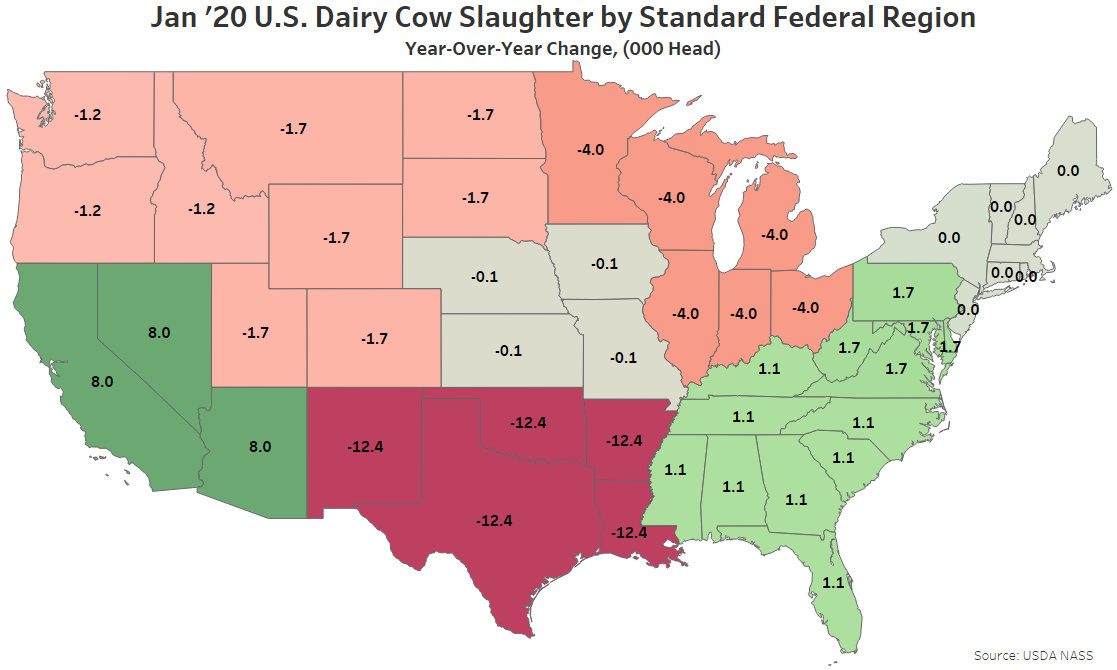 2019 annual dairy cow slaughter rates increased 4.4% on a YOY basis, reaching a 33 year high and a 35 year high level on a percentage of the total dairy cow herd basis.
2019 annual dairy cow slaughter rates increased 4.4% on a YOY basis, reaching a 33 year high and a 35 year high level on a percentage of the total dairy cow herd basis.
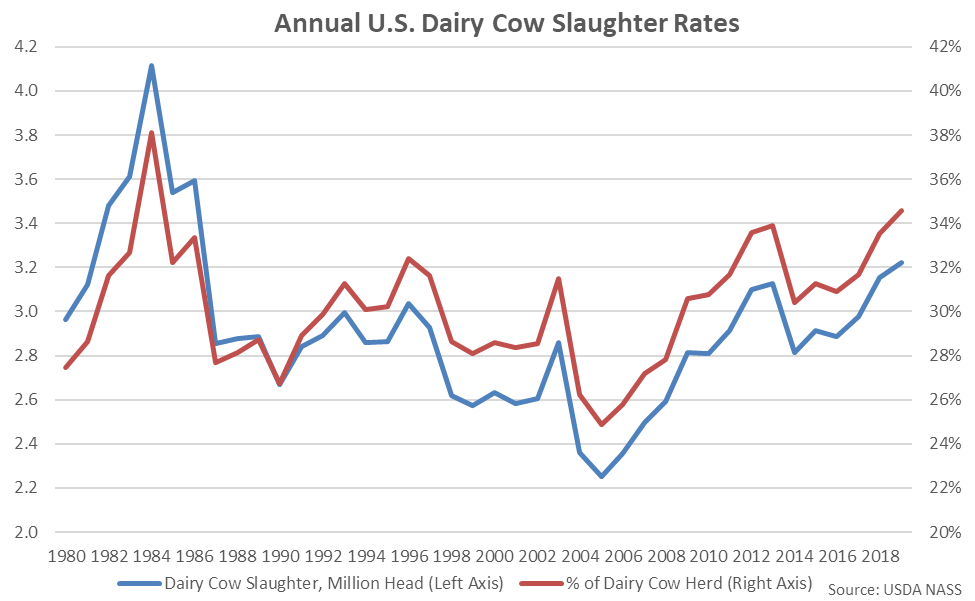
- U.S. dairy cow slaughter rates increased seasonally to a ten month high level while finishing flat on a YOY basis during Jan ’20, remaining at a 34 year high seasonal level.
- MOM increases in dairy cow slaughter were led by Standard Federal Region 9 (Arizona, California, Hawaii and Nevada).
- YOY increases in dairy cow slaughter were led by Standard Federal Region 9 (Arizona, California, Hawaii and Nevada), while dairy cow slaughter rates declined most significantly on a YOY basis throughout Standard Federal Region 6 (Arkansas, Louisiana, New Mexico, Oklahoma and Texas).
 U.S. dairy cow slaughter rates had finished lower on a YOY basis over three consecutive months prior to finishing flat YOY during Jan ’20. Dairy cow slaughter rates had finished higher on a YOY basis over 30 consecutive months prior to the recently experienced declines. U.S. dairy cow slaughter rates have declined by a total of 0.9% on a YOY basis over the past six months.
U.S. dairy cow slaughter rates had finished lower on a YOY basis over three consecutive months prior to finishing flat YOY during Jan ’20. Dairy cow slaughter rates had finished higher on a YOY basis over 30 consecutive months prior to the recently experienced declines. U.S. dairy cow slaughter rates have declined by a total of 0.9% on a YOY basis over the past six months.
 Recent declines in slaughter rates have contributed to the U.S. milk cow herd rebounding from the three year low level experienced during Jul ’19. The U.S. milk cow herd has increased by a total of 33,000 head throughout the past six months, rebounding to an 11 month high level, overall. The U.S. milk cow herd currently stands at 9.348 million head, which remains 6,000 head below the previous year and 90,000 head below the 23 year high level experienced during Jan ’18, however.
Recent declines in slaughter rates have contributed to the U.S. milk cow herd rebounding from the three year low level experienced during Jul ’19. The U.S. milk cow herd has increased by a total of 33,000 head throughout the past six months, rebounding to an 11 month high level, overall. The U.S. milk cow herd currently stands at 9.348 million head, which remains 6,000 head below the previous year and 90,000 head below the 23 year high level experienced during Jan ’18, however.
 The most significant MOM increase in dairy cow slaughter was experienced within Standard Federal Region 9 (Arizona, California, Hawaii and Nevada), followed by Standard Federal Region 10 (Alaska, Idaho, Oregon and Washington).
The most significant MOM increase in dairy cow slaughter was experienced within Standard Federal Region 9 (Arizona, California, Hawaii and Nevada), followed by Standard Federal Region 10 (Alaska, Idaho, Oregon and Washington).
 YOY increases in dairy cow slaughter were led by Standard Federal Region 9 (Arizona, California, Hawaii and Nevada), while dairy cow slaughter rates declined most significantly on a YOY basis throughout Standard Federal Region 6 (Arkansas, Louisiana, New Mexico, Oklahoma and Texas).
YOY increases in dairy cow slaughter were led by Standard Federal Region 9 (Arizona, California, Hawaii and Nevada), while dairy cow slaughter rates declined most significantly on a YOY basis throughout Standard Federal Region 6 (Arkansas, Louisiana, New Mexico, Oklahoma and Texas).
 2019 annual dairy cow slaughter rates increased 4.4% on a YOY basis, reaching a 33 year high and a 35 year high level on a percentage of the total dairy cow herd basis.
2019 annual dairy cow slaughter rates increased 4.4% on a YOY basis, reaching a 33 year high and a 35 year high level on a percentage of the total dairy cow herd basis.
